There is something about fresh green vegetables with an innate bitter taste. Though, this flavor profile may be repulsive for many, for me, it works really well – be it karela (bitter gourd), neem, methi leaves (fresh fenugreek) or others. Also, I know that bitter veggies are brimming with health benefits. Hence, I all the more make it a point to include them in my daily diet. One such simple, nutritious, yet delicious recipe is this Maharashtrian style Methi Bhaji or Methi Sabji. Made with fresh methi leaves, potato, herbs, spices and coconut – this is a tasty Methi ki Bhaji.
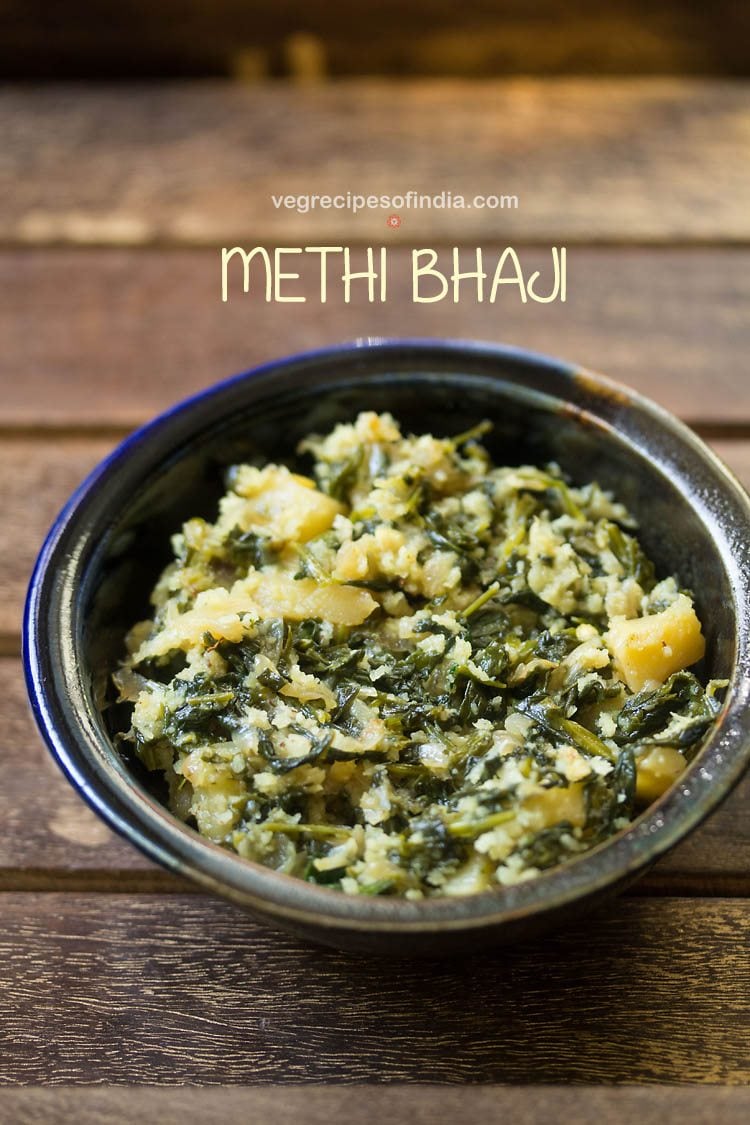
About Methi Bhaji
In simple words, ‘methi’ is fresh fenugreek leaves and the Marathi word ‘bhaji’ refers to a ‘dryish vegetable preparation or sabji.’ This vegan dish is the quickest way you can put your fresh produce of methi leaves into use and make a homely yet sumptuous dish for your lunch or dinner meals.
This Methi Bhaji is also one of those recipes that I have grown up having and my mother would often pack it in my tiffin box along with chapatis. This was a favorite tiffin meal both while studying and then while I was working. In Maharashtrian cuisine, it is also popularly referred to as methi chi bhaji and in Hindi you can call it methi ki bhaji.
How basic and simple can a recipe get? Th best example is this Methi Bhaji. Besides these leafy greens, the recipe includes potato, onion, garlic green chili, turmeric powder and asafoetida. The coconut is just the right finale you can have in this dish, as it imparts an nutty flavor as well as a subtly sweetness to it.
However, if you are packing this Methi Bhaji in tiffin and staying in a hot climate, then don’t add coconut. If preparing for home, then you can add the coconut without thinking twice. In place of fresh coconut, you can also use desiccated coconut.
More On My Recipe
This Methi Bhaji is one of those recipes I make at times with fresh fenugreek leaves to pair with chapatis or as a side dish with dal-rice. Trust me, with a lentil-rice combination, this sabzi made with methi leaves is super comforting.
Usually, I pluck the methi leaves and keep them stored in a box in the refrigerator. So, when I want to prepare any dish with it, I just use the leaves as required and keep the remaining back in the refrigerator.
This way, it is very handy and saves time when you want to use fresh fenugreek leaves in any recipe, like this Methi Bhaji.
Like I said earlier, this methi chi bhaji recipe is very simple and easy to prepare. I have added potatoes in it as I like the flavors together, but you can skip them too.
This recipe serves one to two portions and can be packed in the tiffin. You can easily double the proportions.
Serve Methi Bhaji with roti, phulka or as a side dish with amti-bhaat, dal-rice or varan-bhaat. Few of my other favorite recipes with fresh fenugreek leaves or methi are this Methi Pulao, Methi Paratha, Methi Matar Malai and Methi Dal.
How to make Methi Bhaji
Preparation
1. Rinse 3 cups methi leaves very well in water a few times. Drain all the water. Then, chop the methi leaves.
Also chop 1 medium onion, 1 medium potato, 1 green chili and 3 to 4 small to medium garlic cloves. Keep aside. Chop the potatoes in small cubes, so that they cook quickly.

Make Methi Bhaji
2. In a pan, heat 2 tablespoons oil. Add chopped onion (½ cup chopped onions).
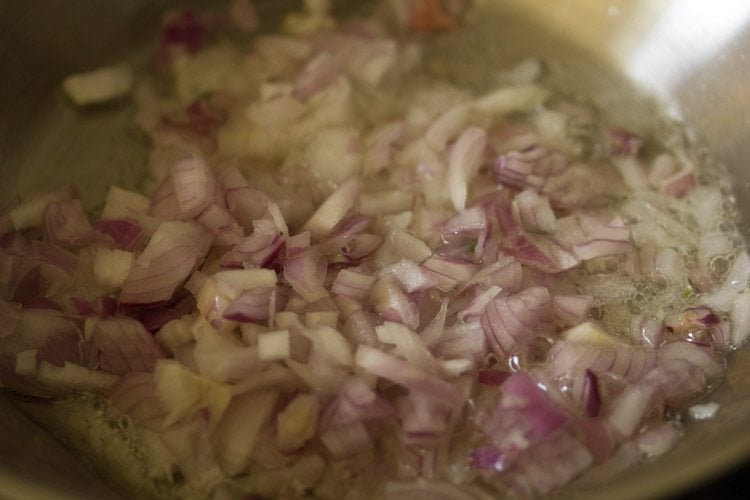
3. Sauté the onions till translucent. Stir often.
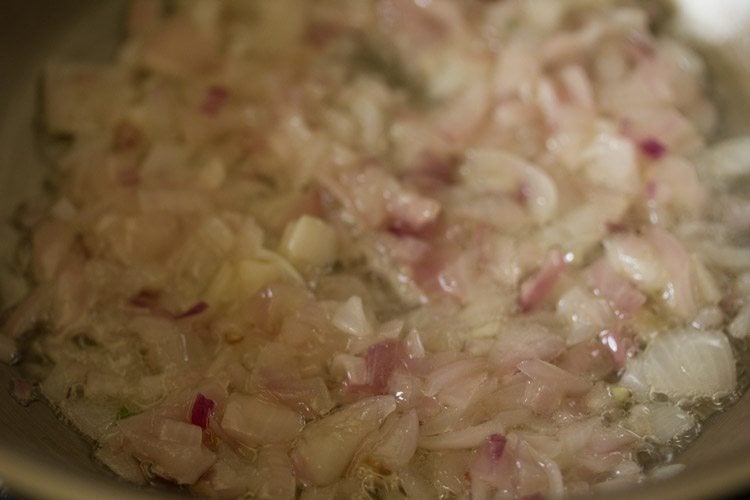
4. Then, add chopped green chili and finely chopped garlic. Mix well and sauté for 3 to 4 seconds.
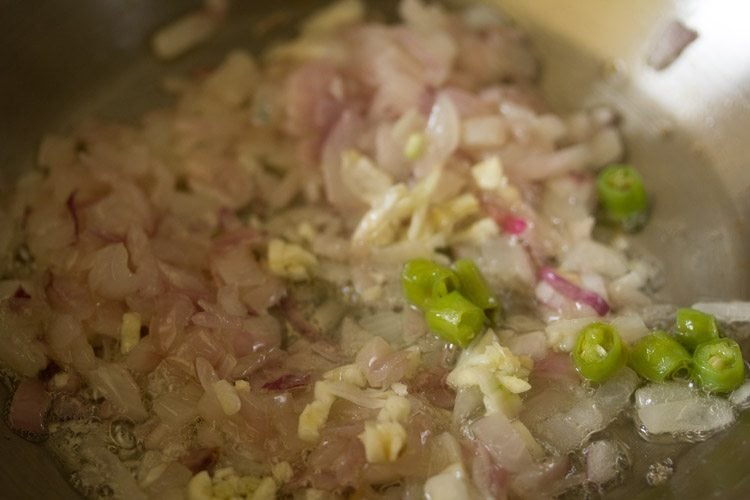
5. Next, add 1 pinch turmeric powder and 1 pinch asafoetida (hing).
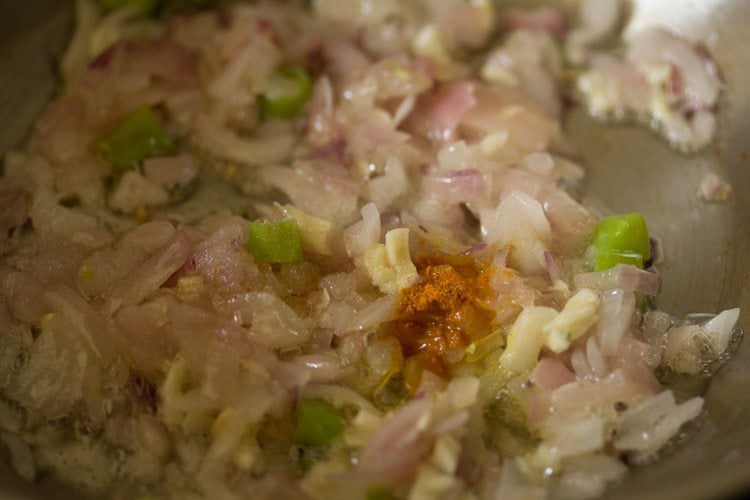
6. Mix very well.

7. Add the chopped potatoes.

8. Mix and sauté the potatoes for 2 to 3 minutes.
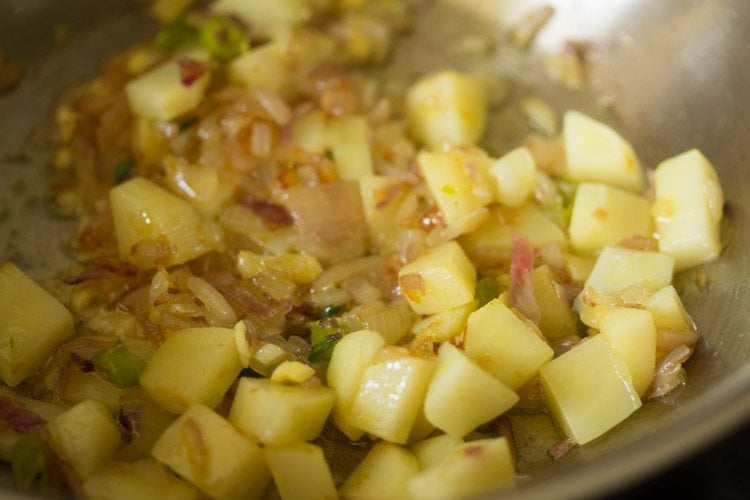
9. Then, add the chopped methi leaves (approximately 50 grams or 3 cups fenugreek leaves).

10. Mix very well and then season with salt as required.

Cook Methi ki Bhaji
11. Cover the pan with a rimmed lid and add water on the lid. Cook on low heat. This technique creates steam in the pan and helps in cooking the vegetables.

12. While the Methi ki Bhaji is cooking, check. Carefully remove the lid as it is very hot. If the bhaji looks dry, add some more water on the lid. Cover and continue to cook.

13. Cook till the potatoes are softened.

14. Once the potatoes are done, add 3 tablespoons fresh grated coconut. If the bhaji has lots of moisture or water, cook it without the lid till the liquids dry up and then add coconut.
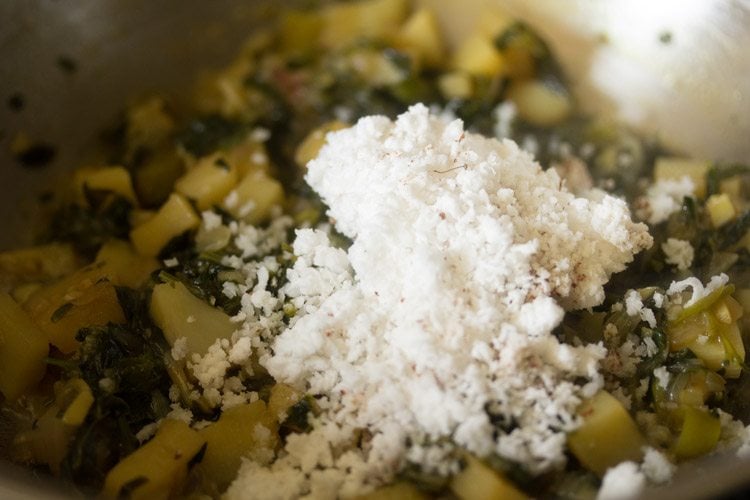
15. Mix very well and sauté for a minute.

16. Serve Maharashtrian style Methi Bhaji hot or warm with chapatis, phulka, plain paratha or as a side dish with amti-bhaat, dal-rice or varan-bhaat.
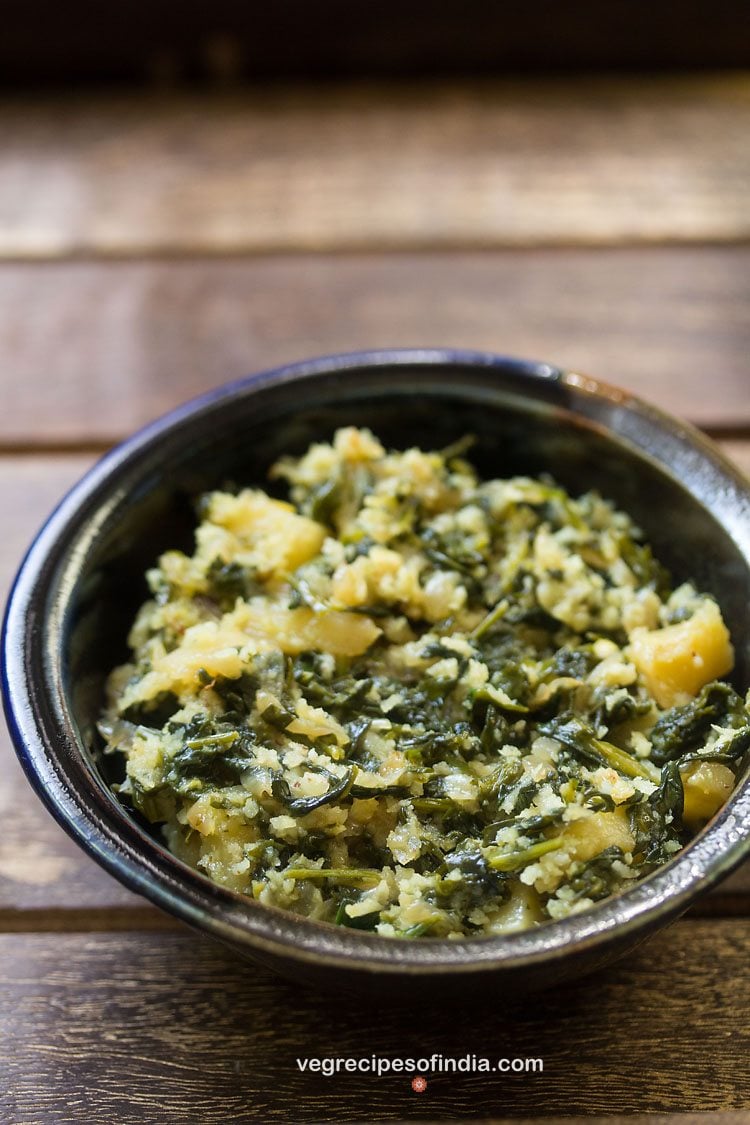
Expert Tips
- You can skip adding fresh coconut, if you want. The potatoes can also be skipped, if needed.
- If you don’t have fresh coconut, you can even use desiccated coconut in the recipe.
- To make the dish gluten-free, skip adding asafoetida (hing) or use a gluten-free asafoetida.
- If adding potatoes, chopping them in small cubes will cook them quickly.
- While cooking the bhaji, if it looks dry, then add some more water on the lid. Then, cover and continue to cook.
- The Methi Bhaji recipe can be easily scaled to double or triple the quantities.
More Similar Recipes To Try!
Vegetable Recipes
Okra Recipes
Vegetable Recipes
Please be sure to rate the recipe in the recipe card or leave a comment below if you have made it. For more vegetarian inspirations, Sign Up for my emails or follow me on Instagram, Youtube, Facebook, Pinterest or Twitter.
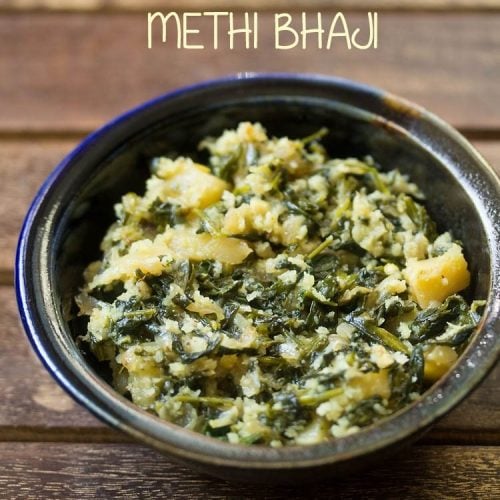
Methi Bhaji | Methi ki Bhaji
Ingredients
- 50 grams fenugreek leaves or 3 cups methi leaves
- 1 potato (medium-sized), cut in small cubes
- 2 tablespoons oil
- 1 onion (medium-sized), chopped or ½ cup chopped onions
- 3 to 4 garlic cloves small to medium-sized, finely chopped
- 1 green chili – chopped or ½ teaspoon chopped
- 3 tablespoons fresh grated coconut – optional
- 1 pinch turmeric powder (ground turmeric)
- 1 pinch asaofetida (hing) – optional
- salt as required
Instructions
Preparation
- Rinse 3 cups methi leaves very well in water. Drain all the water. Then chop the methi leaves.
- Also chop the onion, potato, green chili and garlic cloves. Keep aside.
- Chop the potatoes in small cubes so that they cook quickly.
Making methi ki bhaji
- In a pan heat oil. Once the oil becomes hot, add the chopped onions. Sauté the onions stirring often till translucent on low to medium heat.
- Then add the chopped green chilies and garlic. Mix well and saute for 3 to 4 seconds.
- Next add 1 pinch of turmeric powder (haldi) and 1 pinch of asaofetida (hing). Mix very well.
- Add the chopped potatoes. Mix and then begin to saute the potatoes for 2 to 3 minutes on medium-low heat.
- Then add the chopped methi leaves.
- Mix very well and then season with salt as required.
Cooking methi bhaji
- Cover the pan with a rimmed lid and add water on the lid. Cook on a low heat. This technique creates steam in the pan and helps in cooking the veggies.
- In between do check while the bhaji is cooking. Carefully remove the lid as it is very hot. If the bhaji looks dry then add some more water on the lid. Cover and continue to cook.
- Once the potatoes are done, then add 3 tablespoons coconut. If the bhaji has lots of liquids or water, then cook it without the lid till the liquids dry up and then add coconut.
- Mix very well and saute for a minute.
- Serve methi bhaji hot or warm with chapati or phulka or plain paratha or as a side dish with dal-rice or with any Indian meal.
Notes
- You can skip adding fresh coconut if you want or swap the fresh coconut with desiccated coconut.
- To make the dish gluten-free skip adding asafoetida or use a gluten-free asafoetida.
- Remember to use fresh tender fenugreek leaves. Do not use the stems as they can have a grassy texture when cooked in preparations like these.
- You can easily scale this recipe.
Nutrition Info (Approximate Values)
This Methi Bhaji recipe from the archives first published on April 2017 has been republished and updated on November 2022.
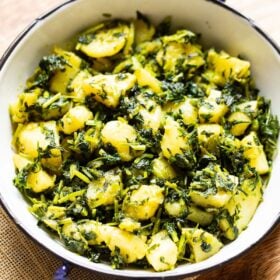

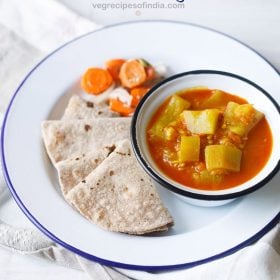
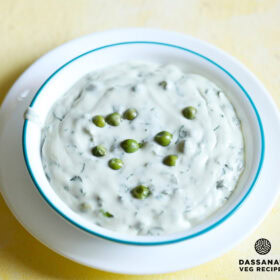
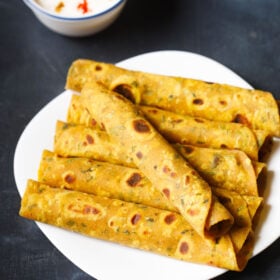
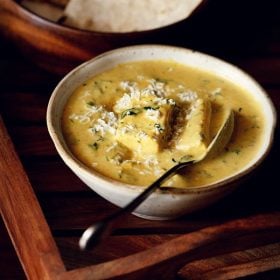









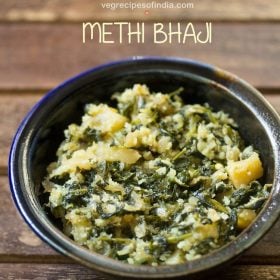
Would this recipe work with frozen Methi leaves?
Yes, but frozen methi will cook faster than fresh leaves. I would suggest to cook the potatoes until they are almost softened or tender and then add the frozen methi leaves.
My mother used to make this very often, it tastes royal.